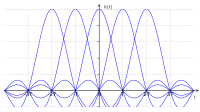
Photo from wikipedia
Abstract The first two decades of the 21st century witnessed adverse effects induced by low-frequency components of severe earthquakes in low-frequency structures. In the 2011 Great East Japan Earthquake, it… Click to show full abstract
Abstract The first two decades of the 21st century witnessed adverse effects induced by low-frequency components of severe earthquakes in low-frequency structures. In the 2011 Great East Japan Earthquake, it was reported that many high-rise buildings suffered long-duration vibration with excessive displacements, resulting in damaged interior and exterior walls. Thus, the development of displacement control technologies for the seismic protection of low-frequency structures has been identified as a growing challenge in the field of earthquake engineering. Previous related studies suggest that rate-independent linear damping (RILD) can be a viable option for reducing excessive displacements in low-frequency structures. Because most of the studies on RILD mainly focused on theoretical aspects, practical applications of RILD have not been investigated. This study mainly aims to examine the feasibility of the physical implementation of RILD. The effectiveness of a passive causal RILD device comprising a Maxwell-type damper and a negative stiffness for the protection of low-frequency structures is examined based on the approaches of real-time hybrid simulation and frequency-domain analysis. The results of this study confirmed that the passive causal RILD device could achieve a control effect in its displacement response and floor response acceleration in low-frequency structures similar to that of ideal RILD for the majority of selected earthquake records.
Journal Title: Structures
Year Published: 2021
Link to full text (if available)
Share on Social Media: Sign Up to like & get
recommendations!